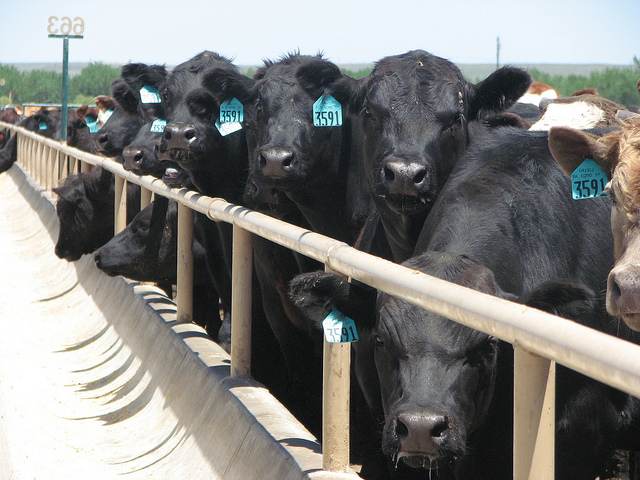
Agricultural News
Why Paralyzed Cattle Markets are Causing Calves to be Undervalued at the Sale Barn
Mon, 24 Oct 2016 10:20:17 CDT
 Mondays, Dr. Derrell Peel, Oklahoma State University Extension Livestock Marketing Specialist, offers his economic analysis of the beef cattle industry. This analysis is a part of the weekly series known as the "Cow Calf Corner" published electronically by Dr. Peel and Dr. Glenn Selk. Today, Dr. Peel explains how feedlot preferences are affecting the price of cattle, given the current market situation.
Mondays, Dr. Derrell Peel, Oklahoma State University Extension Livestock Marketing Specialist, offers his economic analysis of the beef cattle industry. This analysis is a part of the weekly series known as the "Cow Calf Corner" published electronically by Dr. Peel and Dr. Glenn Selk. Today, Dr. Peel explains how feedlot preferences are affecting the price of cattle, given the current market situation.
"Feeder cattle prices to a large degree reflect feedlot choices as they evaluate the tradeoffs between purchasing lighter or heavier feeder cattle. When feeder cattle markets are in "balance:, prices for lighter weight feeder cattle adjust to account for the cost of gain to put the additional weight on those cattle such that feedlots are relatively indifferent to buying feeder cattle of various weights. This is what we observe on average most of the time. Sometimes, anomalies will develop in feeder markets which create different incentives for producers.
"Such is the case this fall. For example, steers with an average weight of 826 pounds (medium/large number 1 at the seven federally reported auctions in Oklahoma) had an average price of $121.59/cwt. last week (October 21, 2016). Given that price, and assuming that feedlot cost of gain is $0.70/pound, feedlots could pay as much as $141/cwt. for a 600 pound steer. However, the average price for 600 pound steers last week in Oklahoma was $119.78/cwt. In fact, the price of 550-600 pound steers was less per pound than all heavier animals up to 850 pounds. There was less than $2/cwt. difference in prices for steers from 600 to 850 pounds. It is very clear that feedlots are placing a large risk premium against lighter feeder cattle. It could be that feedlots simply don't want lighter weight cattle because there is an ample supply of heavy feeder which they often prefer to feed. However, the year over year decrease in September feedlot placements and the fact that feedlot inventories are barely one percent above last year despite the fact that there lots more feeder cattle would suggest that feedlots are not attempting to grow feedlot numbers very fast.
"It will be pointed out that feedlots are losing money and so clearly cannot to pay the full potential price for lighter feeder cattle. However, this analysis is based on what they are paying for heavy feeder cattle when there are lighter weight cattle that are a relative bargain. The bigger problem, it seems, is that feedlots, like everyone else, are gripped by fear of the future. Feedlots appear to be operating very hand to mouth favoring heavy feeders that will finish sooner rather than later. Weak and volatile futures have significantly contributed to this environment.
"The point of this is not to second guess feedlot decisions but rather to look at how cow-calf and stocker producers can react to the price signals in the feeder market today. The almost equal prices for cattle from 550 to 850 pounds translate into a value of gain that is almost equal to the price of cattle. In short, the market is encouraging cattle to stay in the country and come to the feedlots later rather than sooner. That creates stocker opportunities. Calf and stocker prices this fall have been sharply undervalued relative to heavy feeder cattle because stocker demand has not yet kicked in to replace weak feedlot demand for these lighter cattle. It seems that stocker producers (and their lenders) in many cases are gripped by the same fear that is affecting the rest of the industry. Stocker producers who find that Feeder futures offer little to help in managing the obvious risk in this market may want to consider one of the oldest tried and true methods of risk management in cattle markets: buy and sell on the same market. Many producers have taken a financial hit the past 15 months or so and are upside-down financially on cattle right now. The history of the cattle industry has been that many successful producers recognize that today's lousy selling price is a buying opportunity. For cow-calf producers with calves to sell, the same signals suggest that retaining calves for stocker or backgrounding should be evaluated. Certainly, pushing lots of calves into a yearling market next year has risks and means that conditions have to be monitored carefully going forward but the big market signal is clear: there is a need to slow cattle down and spread them out over time and that provides opportunities in the country."
WebReadyTM Powered by WireReady® NSI
Top Agricultural News
More Headlines...



















